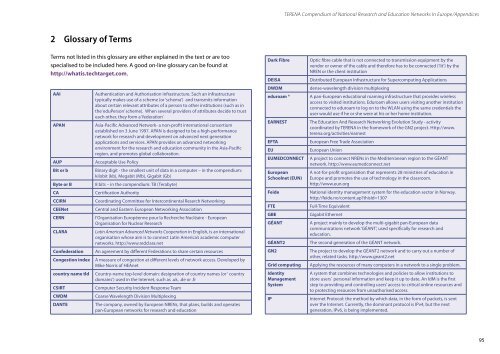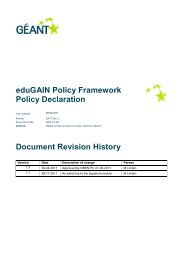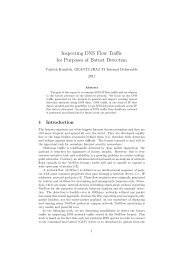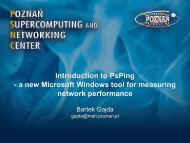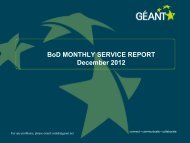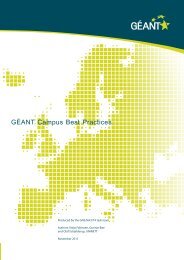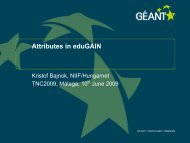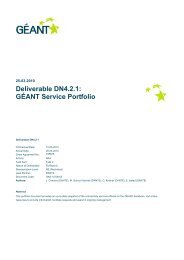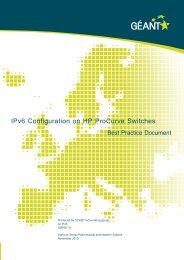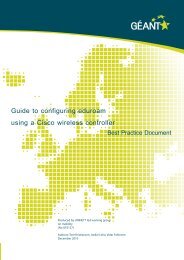TERENA COMPENDIUM - Géant
TERENA COMPENDIUM - Géant
TERENA COMPENDIUM - Géant
Create successful ePaper yourself
Turn your PDF publications into a flip-book with our unique Google optimized e-Paper software.
<strong>TERENA</strong> Compendium of National Research and Education Networks In Europe /Appendices2 Glossary of TermsTerms not listed in this glossary are either explained in the text or are toospecialised to be included here. A good on-line glossary can be found athttp://whatis.techtarget.com.AAIAPANAUPBit or bByte or BCACCIRNCEENetCERNCLARAConfederationCongestion indexcountry name tldCSIRTCWDMDANTEAuthentication and Authorisation Infrastructure. Such an infrastructuretypically makes use of a scheme (or ‘schema’) and transmits informationabout certain relevant attributes of a person to other institutions (such as inthe ‘eduPerson’ scheme). When several providers of attributes decide to trusteach other, they form a ‘federation’Asia-Pacific Advanced Network- a non-profit international consortiumestablished on 3 June 1997. APAN is designed to be a high-performancenetwork for research and development on advanced next generationapplications and services. APAN provides an advanced networkingenvironment for the research and education community in the Asia-Pacificregion, and promotes global collaboration.Acceptable Use PolicyBinary digit - the smallest unit of data in a computer – in the compendium:kilobit (kb), Megabit (Mb), Gigabit (Gb)8 bits – in the compendium: TB (Terabyte)Certification AuthorityCoordinating Committee for Intercontinental Reserch NetworkingCentral and Eastern European Networking Associationl’Organisation Européenne pour la Recherche Nucléaire - EuropeanOrganisation for Nuclear ResearchLatin American Advanced Networks Cooperation in English, is an internationalorganisation whose aim is to connect Latin America’s academic computernetworks. http://www.redclara.netAn agreement by different Federations to share certain resourcesA measure of congestion at different levels of network access. Developed byMike Norris of HEAnetCountry-name top-level domain: designation of country names (or ‘ countrydomains’) used in the Internet, such as .uk, .de or .frComputer Security Incident Response TeamCoarse Wavelength Division MultiplexingThe company, owned by European NRENs, that plans, builds and operatespan-European networks for research and educationDark FibreDEISADWDMeduroam ®EARNESTEFTAEUEUMEDCONNECTEuropeanSchoolnet (EUN)FeideFTEGBEGÉANTGÉANT2GN2Grid computingIdentityManagementSystemIPOptic fibre cable that is not connected to transmission equipment by thevendor or owner of the cable and therefore has to be connected (‘lit’) by theNREN or the client institutionDistributed European Infrastructure for Supercomputing Applicationsdense-wavelength division multiplexingA pan-European educational roaming infrastructure that provides wirelessaccess to visited institutions. Eduroam allows users visiting another institutionconnected to eduroam to log on to the WLAN using the same credentials theuser would use if he or she were at his or her home institution.The Education And Research Networking Evolution Study - activitycoordinated by <strong>TERENA</strong> in the framework of the GN2 project. Http://www.terena.org/activities/earnestEuropean Free Trade AssociationEuropean UnionA project to connect NRENs in the Mediterranean region to the GÉANTnetwork. http://www.eumedconnect.netA not-for-profit organisation that represents 28 ministries of education inEurope and promotes the use of technology in the classroom.http://www.eun.orgNational identity management system for the education sector in Norway.http://feide.no/content.ap?thisId=1307Full-Time EquivalentGigabit EthernetA project mainly to develop the multi-gigabit pan-European datacommunications network ‘GÉANT’, used specifically for research andeducation.The second generation of the GÉANT network.The project to develop the GÉANT2 network and to carry out a number ofother, related tasks. http://www.geant2.netApplying the resources of many computers in a network to a single problem.A system that combines technologies and policies to allow institutions tostore users` personal information and keep it up to date. An ldM is the firststep to providing and controlling users’ access to critical online resources andto protecting resources from unauthorised access.Internet Protocol: the method by which data, in the form of packets, is sentover the Internet. Currently, the dominant protocol is IPv4, but the nextgeneration, IPv6, is being implemented.95


